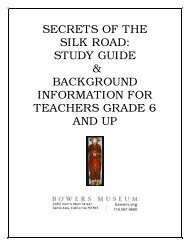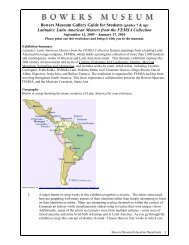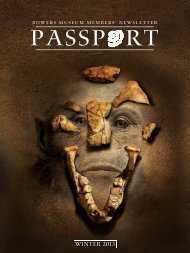A Resource Guide for Students and Teachers - Bowers Museum
A Resource Guide for Students and Teachers - Bowers Museum
A Resource Guide for Students and Teachers - Bowers Museum
You also want an ePaper? Increase the reach of your titles
YUMPU automatically turns print PDFs into web optimized ePapers that Google loves.
Imperial capital<br />
Artist’s rendering by<br />
Hsien-Min Yang<br />
The First Emporer had one of each<br />
book retained in a library which was<br />
burned by his enemies after his death.<br />
Much of the teachings of Confucius<br />
had to be rewritten from the memory<br />
of his followers.<br />
The First Emperor was influenced<br />
by the Legalist writings of Han Feizi<br />
who wrote that people are selfish <strong>and</strong><br />
rulers should reward their subjects <strong>for</strong><br />
loyalty <strong>and</strong> severely punish disloyalty.<br />
The First Emperor established an<br />
absolute right of comm<strong>and</strong>. This<br />
meant that the ruler had complete<br />
power over the people who had<br />
no rights. This was exercised by<br />
establishing “responsibility groups”;<br />
households were organized into<br />
groups which were obligated to in<strong>for</strong>m<br />
authorities if anyone failed to carry<br />
out their assigned duties or broke the<br />
law. People who turned in lawbreakers<br />
were rewarded; people who did not<br />
turn in lawbreakers were executed.<br />
This tradition of absolute power<br />
remained a principle of government<br />
in China to modern times.<br />
To carry out the First Emperor’s<br />
gr<strong>and</strong> projects required huge numbers<br />
of laborers. Men who would have<br />
normally worked in the fields raising<br />
food were conscripted into the army<br />
<strong>for</strong> a year or more <strong>and</strong> then to work<br />
in the emperor’s service <strong>for</strong> another<br />
year. They were <strong>for</strong>ced to work on<br />
the building projects such as the<br />
roads, canals, palaces, his tomb <strong>and</strong><br />
the great wall. Thous<strong>and</strong>s of people<br />
died carrying out his comm<strong>and</strong>s.<br />
Shortages of farmers led to food<br />
shortages which led to rebellions<br />
against the emperor. Embittered<br />
subjects from farmers to aristocrats<br />
<strong>and</strong> intellectuals hated him <strong>for</strong> his<br />
oppressions <strong>and</strong> heavy taxation.<br />
Several assassination attempts against<br />
him led the First Emperor to build<br />
secret passageways throughout his<br />
great palace. When going out in the<br />
evening, he went in disguise. And<br />
every night he slept in a different<br />
location.<br />
The First Emperor toured his<br />
conquered states to establish his<br />
legitimacy <strong>and</strong> impress his subjects,<br />
but also to find magicians who<br />
could promise him eternal life.<br />
Un<strong>for</strong>tunately one of their solutions<br />
contained mercury. It is believed he<br />
died from mercury poisoning while<br />
on one of his tours.<br />
When he died in 210 BCE, the<br />
peasants rebelled against Hu Hai,<br />
the emperor’s successor, who was a<br />
less powerful ruler. They destroyed<br />
the First Emperor’s great palaces <strong>and</strong><br />
buildings, yet the tombs survived. Out<br />
of the chaos emerged the Han dynasty.<br />
A sunflower surrounded by clouds is featured on the roof tile that once<br />
decorated the First Emporer’s palace. The tile was excavated in 1995<br />
when a road-widening project next to the tomb revealed the palace.<br />
17





